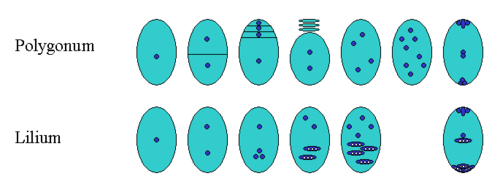In seed plants, the ovule is the structure that gives rise to and contains the female reproductive cells. It consists of three parts: the integument, forming its outer layer, the nucellus (or remnant of the megasporangium), and the female gametophyte (formed from a haploid megaspore) in its center. The female gametophyte — specifically termed a megagametophyte— is also called the embryo sac in angiosperms. The megagametophyte produces an egg cell for the purpose of fertilization.
In flowering plants, the ovule is located inside the portion of the flower called the gynoecium. The ovary of the gynoecium produces one or more ovules and ultimately becomes the fruit wall. Ovules are attached to the placenta in the ovary through a stalk-like structure known as a funiculus (plural, funiculi). Different patterns of ovule attachment, or placentation, can be found among plant species, these include:[1]
- Apical placentation: The placenta is at the apex (top) of the ovary. Simple or compound ovary.
- Axile placentation: The ovary is divided into radial segments, with placentas in separate locules. Ventral sutures of carpels meet at the centre of the ovary. Placentae are along fused margins of carpels. Two or more carpels. (e.g. Hibiscus, Citrus, Solanum)
- Basal placentation: The placenta is at the base (bottom) of the ovary on a protrusion of the thalamus (receptacle). Simple or compound carpel, unilocular ovary. (e.g. Sonchus, Helianthus, Compositae)
- Free-central placentation: Derived from axile as partitions are absorbed, leaving ovules at the central axis. Compound unilocular ovary. (e.g. Stellaria, Dianthus)
- Marginal placentation: Simplest type. There is only one elongated placenta on one side of the ovary, as ovules are attached at the fusion line of the carpel's margins . This is conspicuous in legumes. Simple carpel, unilocular ovary. (e.g. Pisum)
- Parietal placentation: Placentae on inner ovary wall within a non-sectioned ovary, corresponding to fused carpel margins. Two or more carpels, unilocular ovary. (e.g. Brassica)
- Superficial: Similar to axile, but placentae are on inner surfaces of multilocular ovary (e.g. Nymphaea)
In gymnosperms such as conifers, ovules are borne on the surface of an ovuliferous (ovule-bearing) scale, usually within an ovulate cone (also called megastrobilus). In the early extinct seed ferns, ovules were borne on the surface of leaves. In the most recent of these taxa, a cupule (a modified branch or group of branches) surrounded the ovule (e.g. Caytonia or Glossopteris).
Megagametophyte[edit]
The haploid megaspore inside the nucellus gives rise to the female gametophyte, called the megagametophyte.
In gymnosperms, the megagametophyte consists of around 2000 nuclei and forms archegonia, which produce egg cells for fertilization.
In flowering plants, the megagametophyte (also referred to as the embryo sac) is much smaller and typically consists of only seven cells and eight nuclei. This type of megagametophyte develops from the megaspore through three rounds of mitotic divisions. The cell closest to the micropyle opening of the integuments differentiates into the egg cell, with two synergid cells by its side that are involved in the production of signals that guide the pollen tube. Three antipodal cells form on the opposite (chalazal) end of the ovule and later degenerate. The large central cell of the embryo sac contains two polar nuclei.
Zygote, embryo and endosperm[edit]
The pollen tube releases two sperm nuclei into the ovule. In gymnosperms, fertilization occurs within the archegonia produced by the female gametophyte. While it is possible that several egg cells are present and fertilized, typically only one zygote will develop into a mature embryo as the resources within the seed are limited.[citation needed]
In flowering plants, one sperm nucleus fuses with the egg cell to produce a zygote, the other fuses with the two polar nuclei of the central cell to give rise to the polyploid (typically triploid) endosperm. This double fertilization is unique to flowering plants, although in some other groups the second sperm cell does fuse with another cell in the megagametophyte to produce a second embryo. The plant stores nutrients such as starch, proteins, and oils in the endosperm as a food source for the developing embryo and seedling, serving a similar function to the yolk of animal eggs. The endosperm is also called the albumen of the seed.[citation needed] the zygote then develops into a megasporophyte, which in turn produces one or more megasporangia. The ovule, with the developing megasporophyte, may be described as either tenuinucellate or crassinucellate. The former has either no cells or a single cell layer between the megasporophyte and the epidermal cells, while the latter has multiple cell layers between.[7]
Embryos may be described by a number of terms including Linear (embryos have axile placentation and are longer than broad), or rudimentary (embryos are basal in which the embryo is tiny in relation to the endosperm).[8]
Types of gametophytes[edit]
Megagametophytes of flowering plants may be described according to the number of megaspores developing, as either monosporic, bisporic, or tetrasporic.[citation needed](RF)
See also[edit]
https://en.wikipedia.org/wiki/Ovule




No comments:
Post a Comment